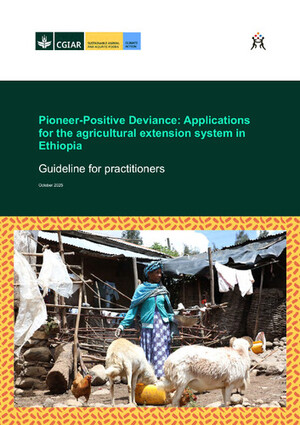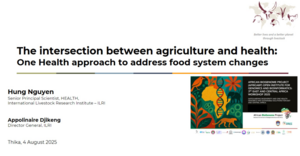
Towards sustainable food system transformations in the Global South
The world is just eleven harvests away from 2030, but for hundreds of millions of people the goal of ending hunger set forth in the United Nations’ Sustainable Development Goals (SDG) remains as loftily elusive as ever. What can be done to put the developing world on the right track?
A side event convened last week by the CGIAR at the Committee on World Food Security (CFS), Road Testing Healthy Diets: Perspectives from the Global South, brought together speakers from governments of African countries, multilateral and bilateral development partners, civil society and the CGIAR science community to discuss the vital role for agricultural and policy research for the global south. The International Livestock Research Institute’s Iain Wright was among the speakers.
The problem: More than 800 million people are routinely hungry, deprived of the nutrients and calories that make it possible to live a healthy human life. An additional 1.3 billion people are episodically hungry, unable to count on getting enough nutritious food to feed themselves and their families from one day—or one season—to the next.
Over the years, the United Nations and other international organizations have put forth various road maps and target goals for putting an end to this most ancient of human scourges. Most prominently, in 2015 the UN proposed the world commit to 17 sustainable development goals (SDGs) to focus the global development agenda, and set the year 2030 as the date to meet them. The first of these SDGs is ending extreme poverty. The second is ending hunger.
People are disposed to focus on the negatives: When a plane crashes, it’s a news story, but if it lands on time no one notices. That tendency can lead us to think that the world is worse off than it is. So it’s important to stress that an astonishing amount of progress has been made on many of the SDGs: The number of hungry has been slashed by half in the past two decades alone, and places such as Ethiopia, India and Bangladesh have all-but eliminated the widespread hunger and episodic famines that were once synonymous with their name.
But in the past three years, that progress has not only slowed but slightly reversed. In large swathes of sub-Saharan Africa and southern Asia, and in pockets of Latin America and elsewhere in the developing world, hunger is not only persisting but getting modestly worse. At the same time, the world is growing increasingly aware of the dangers that global climate change might pose to all of us—including the small-scale farmers who continue to provide the majority of the world’s food.
A recent report from the EAT-Lancet Commission on Food, Planet, Health warned that the world’s agricultural systems are already under strain, and that feeding the world’s projected population of ten billion by 2050 under current conditions would be catastrophic for the earth, as well as unhealthy for many of us. It recommended dramatic shifts in food production systems, transforming diets and reducing food waste.
That report was criticized for focusing largely on the richer, more developed countries. Gebregziabher Gebreyohannes, Ethiopia’s state minister for livestock and fishery and an ILRI board member, spoke for many when he wrote that Ethiopia’s cows, sheep, goats, chickens, camels and other animals ‘are bringing wealth to all actors in the livestock value chain, especially rural women who lack other opportunities to make money’.
Namukolo Covic of the International Food Policy Research Institute (IFPRI) opened the event by observing that the Eat-Lancet report had sparked a useful debate on what a healthy diet means in different contexts. ‘In low and middle income countries animal-source food (ASF) consumption remains extremely low, particularly for at-risk populations like infants, pregnant women and the elderly’. She noted that ‘equal treatment is not always what’s needed in addressing problems such as obesity. Lessons should be learned to chart a more positive direction for the global south, avoiding the mistakes made elsewhere’.
Diets worldwide remain problematic, she observed. Health outcomes are sub-optimal in developed as well as developing countries, with undernutrition, obesity and diet-related non-communicable diseases widespread. In addition, our food systems are increasingly challenged by climate change, environmental degradation and loss of biodiversity. But there are opportunities as well as challenges, she noted: So what might be some of the low-hanging fruit, some easy wins, that we could take advantage of?
ILRI’s Wright spoke on the vital importance of ASF in developing countries. They provide calories and micro-nutrients that cannot easily be replaced, he said. The costs of not consuming ASF are visible in the stunting that affects far too many children, especially in Africa. ‘It’s a nutrition issue’, he said, but it’s more than that. It’s a health issue, and it’s an economic issue. It’s estimated that 10% of Africa’s GDP is lost every year to stunting.’
Unfortunately, he said, calls to reduce consumption of animal-source foods in the developed world tend to spill over into the developing world. Yet the situations could not be more different: The average African eats about 8 kilograms of meat a year; the average European eats about 70 kilograms, and the average American eats more still.
He noted that demand for ASF continues to skyrocket in the developing world and that this demand can be met in one of three ways: Through imports, industrialization or intensification. The first is problematic and the second remains challenging. Demographic trends for the next twenty or thirty years show that a large percentage of Africa’s population will remain rural, and they will have few livelihood options aside from smallholder, typically mixed crop-livestock farming systems. The good news is that there are abundant opportunities to make those farms more productive. The average Kenyan cow produces less than 10% of the milk of her European counterpart; raising those numbers even a little can produce meaningful outcomes for the farmers.
In fact, increasing smallholder productivity would represent not just a win-win, but a triple win. Farmers (many of them women) would increase their income; ASFs would become more available and affordable, leading to reduced malnutrition, and increased productivity would result in a lower environmental footprint per unit of food produced. In India, for example, a doubling of milk productivity—an entirely feasible goal—would mean that the number of cows needed would be halved and the total GHC emissions from the national dairy herd would be reduced by 25%.
Other speakers noted the importance of boosting the productivity of smallholder farms. Better access to improved farm inputs and services, and more productive, nutritious and environmentally sensitive crops and livestock are needed to help the 500 million small farms, most in the global south. Roots and tubers are needed as both cash crops and as subsistence foods; biofortification remains a promising option, and better integration of the food production system into markets and the financial system can produce significant productivity increases.
Sara Mbago-Bhunu, the director of the east and southern Africa division of the International Fund for Agricultural Development (IFAD), closed out the meeting by making four observations. First, she said, it’s clear that we can’t neglect the interface between environmental concerns on the one hand and healthy diets on the other. One low-hanging fruit, she said, might be the development of dietary guidelines for developing countries. Second we need to better measure the real environmental costs of our current food systems—because without good measurements it’s impossible to determine where the problems are or how to improve. Third, we need to consider much more deeply the implications of power and political economy on food systems and on the ground-level impact of our initiatives. An agenda driven largely by the global North risks undermining the needs of the global South. Finally, she said, we need to be more conscious about the relationship between income and revenue streams, on the one hand, and nutritional outcomes on the other.
For more on the CFS side event, see this write-up from the CIP, International Potato Center. And here is a short video on placing the Global South front and center in our debates on planetary diets.



















